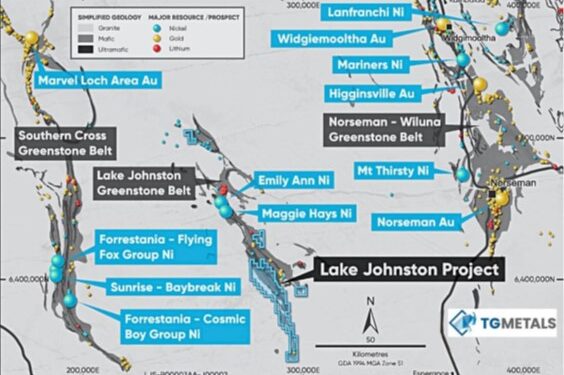TG Metals Limited (ASX:TG6) has successfully completed a detailed nickel sulphide target generation review over approximately 30-kilometre strike of the Lake Johnston Project in Western Australia.
This review was a major undertaking and incorporates decades of legacy exploration data, collated for the very first time. The size of the target area and the number of targets generated is substantial and it provides an exciting opportunity in a region of proven nickel sulphide endowment.
The collation and interrogation of historical exploration data provides a great foundation for the Company’s exploration going forward.
The initial focus is on ultramafic rocks that host the Maggie Hays and Emily Anne nickel deposits to the north.
Within this trend TG Metals has identified:
• Nine priority ground electromagnetic (EM) conductors that have not been tested by drilling. Including three targets defined as drill-ready targets with no additional definition work required.
• Twelve areas have been identified as requiring additional ground EM. Modern high-powered ground EM will be beneficial in better defining targets at depth or differentiating between nickel sulphide mineralisation and sulphidic sediments (barren sulphides).
• Other immediate drill targets include following up anomalous historical nickel drill intercepts, that may represent primary nickel sulphide mineralisation. Ground EM crews are booked to commence early October and are expected to test up to 12 priority areas, initially focusing on the BR02 and BR06 areas covering the favourable Lake Johnston Ultramafic Trend.
Priority Targets Identified
A summary of the priority targets is presented below. More detail on these targets will be provided with the commencement of exploration to further test anomalies.
The review has defined:
• Nine existing EM targets that remain a high priority and warrant follow-up exploration in the form of drill testing. Of these three are considered drill ready, including prospects Eland Road, Highfield and Stamford Bridge. These EM anomalies were not drilled by previous explorers. Companies Maggie Hays Nickel and LionOre Mining International interpreted the conductors to be sulphidic banded iron formation (BIF), due to the surface geochemistry being low in nickel, copper and chromium. The EM anomalies are located on the basal contact of the ultramafic trends, have a very strong signature (high conductance), over short strike lengths (typically BIF’s are long)
• Twelve new target areas that are recommended for follow-up exploration and consist of a mix of unexplored ultramafics, magnetic features and previous exploration results that were not followed up. These areas are recommended for further new ground EM aimed at detecting new conductors. Two that are considered high priority include BR02 and BR06/BR06a. Both BR02 and BR06/BR06a are in areas of deep weathering and covered by deep nickel/cobalt rich laterite deposits. Much of the past geophysics in these areas has not provided a good test of the bedrock.
Past drilling of these targets has intersected strong laterite mineralisation (in places excess of 2% nickel) as historically reported by White Cliff Minerals Limited (2015 to 2019). While the level of laterite nickel development is not an indicator of bedrock anomalism, Target BR06a is focused on drill holes hosting deep (well below the laterite deposits), high-tenor oxide nickel in weakly weathered bedrock.
Next Steps
Follow-up exploration in the form of new ground EM and drill testing of existing target anomalies will be conducted over the coming months, commencing with ground EM in early October and drilling following the necessary grant of approvals including heritage and environmental clearances.
For further information please visit: https://tgmetals.com.au/












